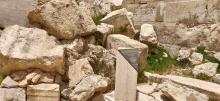
I'm preparing to preach on Mark 13 in a couple of Sundays time, and find myself once again reaching for R T France's excellent commentary on Mark (paid link). I see I've quoted bits from his comments on Mark 13 before (15 years ago actually; where does the time go?!)
However I was just struck again by one short section.
Basically, almost all commentators agree that Mark 13 starts with a discussion of the fall of Jerusalem and its temple. The debate is how long the focus remains there, and whether at some point a further-future eschatological focus comes in.
N T Wright argues that the whole chapter is about the fall of Jerusalem. R T France engages with that, showing why he thinks the focus changes at Mark 13:32. I'm persuaded by his arguments.
However he finds himself agreeing with Tom Wright about verses 24-27, which is where the debate tends to focus.
“For the crucial verses 24-27 this view corresponds with my own conviction that the apocalyptic language of these verses, drawn entirely from identifiable OT texts, relates, as did those texts in their own contexts, not to the collapse of the physical universe and the end of the world but to imminent and far-reaching political change, in the context of the predicted destruction of Jerusalem. On this view the ‘coming of the Son of Man’ is language not about an eschatological descent of Jesus to the earth but, as in the vision of Daniel from which it derives, about the vindication and enthronement of the Son of Man at the right hand of God, to receive and exercise supreme authority. In other words, what is being described in vv. 24-27, as in the OT passages from which their language is drawn, is a change of government: the temple, and all that it stood for is out, and the Son of Man is in.” (Pages 500-501)
Not One Stone on Another
The photo at the top of this post is from the just outside the southern wall of the temple mount in Jerusalem, where some of the "massive stones" from Mark 13:1 can still be seen restored in-situ. The photo is of stones from Herod's temple, after the Romans had finished with them. "Not one stone here will be left on another; every one will be thrown down" (Mark 13:2).
Hard to Swallow
The idea that verses 24-27 is about the fall of Jerusalem is one that most modern Christians instinctively push back against.
“At this point it is as well to recognise that it meets with instinctive resistance on the part of almost all Christian readers simply because we have been brought up to believe that the sort of apocalyptic language used in vv. 24-27, and in particular the vision of ‘the Son of Man coming in clouds’ belongs exclusively to the Parousia and related events of the ‘last days’. … So deeply ingrained is this instinctive interpretation that it is hard for those brought up on the traditional view to appreciate the force of an exegesis that starts from the OT sense of such language rather than from its subsequent Christian development.” (Page 502)
Recent comments